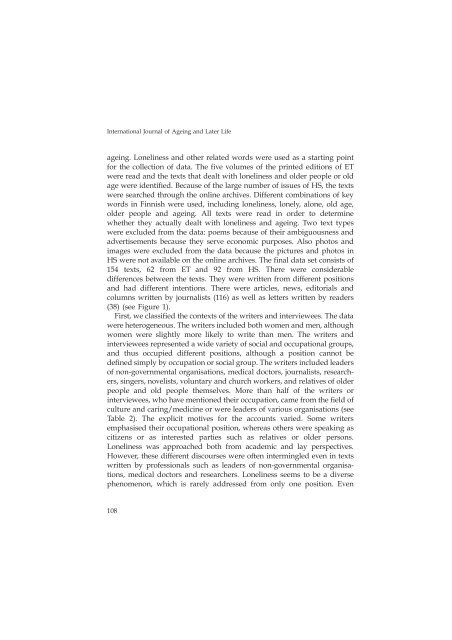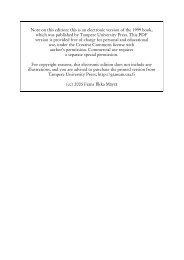Avaa tiedosto - TamPub - Tampereen yliopisto
Avaa tiedosto - TamPub - Tampereen yliopisto
Avaa tiedosto - TamPub - Tampereen yliopisto
Create successful ePaper yourself
Turn your PDF publications into a flip-book with our unique Google optimized e-Paper software.
International Journal of Ageing and Later Life<br />
ageing. Loneliness and other related words were used as a starting point<br />
for the collection of data. The five volumes of the printed editions of ET<br />
were read and the texts that dealt with loneliness and older people or old<br />
age were identified. Because of the large number of issues of HS, the texts<br />
were searched through the online archives. Different combinations of key<br />
words in Finnish were used, including loneliness, lonely, alone, old age,<br />
older people and ageing. All texts were read in order to determine<br />
whether they actually dealt with loneliness and ageing. Two text types<br />
were excluded from the data: poems because of their ambiguousness and<br />
advertisements because they serve economic purposes. Also photos and<br />
images were excluded from the data because the pictures and photos in<br />
HS were not available on the online archives. The final data set consists of<br />
154 texts, 62 from ET and 92 from HS. There were considerable<br />
differences between the texts. They were written from different positions<br />
and had different intentions. There were articles, news, editorials and<br />
columns written by journalists (116) as well as letters written by readers<br />
(38) (see Figure 1).<br />
First, we classified the contexts of the writers and interviewees. The data<br />
were heterogeneous. The writers included both women and men, although<br />
women were slightly more likely to write than men. The writers and<br />
interviewees represented a wide variety of social and occupational groups,<br />
and thus occupied different positions, although a position cannot be<br />
defined simply by occupation or social group. The writers included leaders<br />
of non-governmental organisations, medical doctors, journalists, researchers,<br />
singers, novelists, voluntary and church workers, and relatives of older<br />
people and old people themselves. More than half of the writers or<br />
interviewees, who have mentioned their occupation, came from the field of<br />
culture and caring/medicine or were leaders of various organisations (see<br />
Table 2). The explicit motives for the accounts varied. Some writers<br />
emphasised their occupational position, whereas others were speaking as<br />
citizens or as interested parties such as relatives or older persons.<br />
Loneliness was approached both from academic and lay perspectives.<br />
However, these different discourses were often intermingled even in texts<br />
written by professionals such as leaders of non-governmental organisations,<br />
medical doctors and researchers. Loneliness seems to be a diverse<br />
phenomenon, which is rarely addressed from only one position. Even<br />
108














